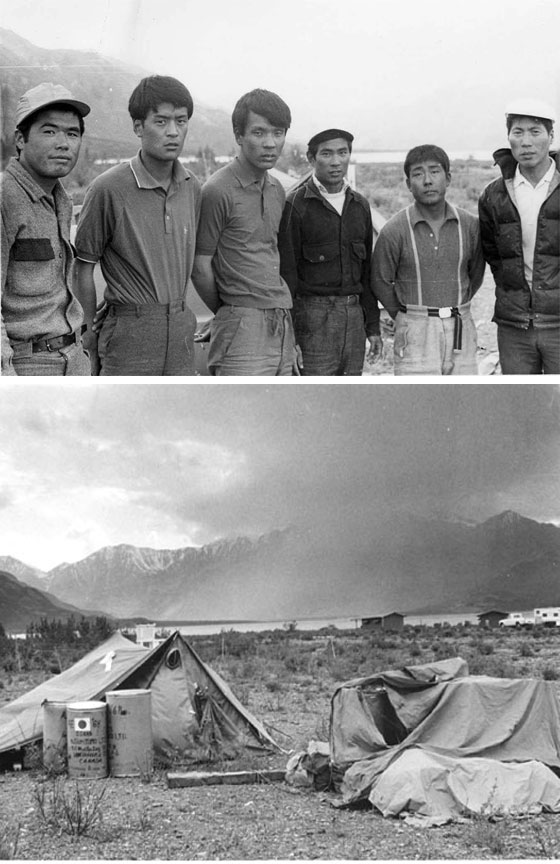Buddhist Rites Mark Cremation of Climbers In Quiet Yukon Valley
In a lonely spot far up a Yukon mountain valley, six young Japanese Alpine climbers Sunday performed the traditional Buddhist cremation ceremony for the bodies of two companions lost in an avalanche in the St. Elias range three weeks before.
By Whitehorse Star on July 4, 1968
The Whitehorse Star
Thursday, July 4, 1968
In a lonely spot far up a Yukon mountain valley, six young Japanese Alpine climbers Sunday performed the traditional Buddhist cremation ceremony for the bodies of two companions lost in an avalanche in the St. Elias range three weeks before.
The body of a third young man Yasuhiro Sawada, was never recovered, despite a search of seven days up at the 10,000 foot level on Mount Vancouver. The ashes of Yoshikazu Nishikawa, 27, and Toshiaki Miyamoto, 25, will be carried home to their families in Osaka by other members of the ill-fated expedition this week.
Choosing a quiet spot away from the Alaska Highway, the six friends drove up the Bullion Creek Road near Sheep Mountain, along the edge of the Slim's River Valley. All day Saturday they gathered driftwood and brush, to construct the traditional funeral pyre. Logs were placed carefully in a square, inter-locked and piled higher in layers, topped by evergreen branches.
Yukon wild flowers were placed around the edge of the pyre.
Burned with the bodies of the two climbers was the broken piece of climbing rope which had plunged them to their death 200 feet below on a wall of ice, and two tiny flags.
Corporal Bill Donoghue of the RCMP detachment at Haines Junction was the only observer of the cremation rites. He had handled the official paper-work following the arrival at the Kluane airstrip of the remainder of the party. Coroner Ron Watson issued the certificates of death, and said no inquest would be necessary. The bodies were then officially released to the climber's companions, in the absence of next-of-kin, all of whom live in Osaka.
Corporal Donoghue stayed in the background during the Buddhist rites, and says he was there mainly to ensure privacy for the Japanese in the event that any curious tourist spotted the smoke and came to have a look. (Macabre touch: an official burning permit was kept handy.)
TORONTO INTERPRETER
Interviewed by The Star, after they had returned from their twelve hour vigil Sunday, the party's interpreter Yoshio Mizuta shrank from any talk of details. He said "It was awful .... terrible".
Mizuta is a world-famous Judo instructor, at present teaching the art in Toronto, and is also a qualified mountain climber, who joined the Osaka group as official interpreter on the Yukon expedition. He will be returning to Toronto when the other five fly home to Osaka this week.
The cremation rites were nothing new to this young man; in his climbing experience he has assisted in such rites for a total of eight friends. The Buddhist belief requires that the ashes of the dead person be returned to their home shrine in order that the spirit may be at rest.
REACHED SUMMIT
Two members of the group had reached the summit of the south peak of Mount Vancouver. They were Masaru Shibata, 24 and Shoichi Kimura, 20. The other three who lost their lives were about 160 feet below Camp 11, located at the 10,170 foot level.
GNA pilot Lloyd Ryder had flown the party into their base camp on the Upper Seward Glacier at about 5900 feet, on May 28 and had arranged to come back in a month's time. On Wednesday, June 26, the weather was good and Ryder flew over to see if the party was ready to come out. It was then learned for the first time, that disaster had struck the expedition.
The party was not equipped with long range radio, and used only walkie-talkie sets for communication among themselves.
RYDER RESCUE
Ryder made three or four separate flights Wednesday to bring the bodies of the two dead climbers and the other seven Alpinists back out safely to the Kluane airstrip, where they were involved for several hours sending official messages to Japan to the families of the dead men, and to the Japanese Consult in Vancouver. Then they fell into bed and slept.
Only one member of the party, Mr. Mizuta, speaks English. He was one of the four expedition members who stayed at Camp 1 at the 7,052 level while the others completed the climb, and was not there when the avalanche struck.
The official account of the accident, as released by Dr. M.G. Marcus, project chief at the Ice field Ranges Research Station at Kluane Lake was as follows:
"On the 10th day of June, three members of a ten-man Japanese expedition on the South ridge of Mount Vancouver were caught in an avalanche at the 10,000 foot level. The three died. Their names are being withheld pending notification of next of kin in Japan.
The expedition was under the leadership of Nobuo Kuwahara, 36, and had as its objective the summit of Mount Vancouver.
At the time of the accident, two members of the party were on the summit of the south peak of Mount Vancouver. Those who were lost in the avalanche were climbing the steep slopes between Camp One and Camp Two on the summit.
They were swept over an ice-fall. The other five members immediately went to the accident area and recovered two bodies. The third was never found although the search was maintained for seven days.
All members were safely returned to the Kluane airstrip on Wednesday, June 26 and will return to Osaka. They were members of the Federation of Japanese Alpine Climbers, and went in to Mount Vancouver area May 28."

Be the first to comment